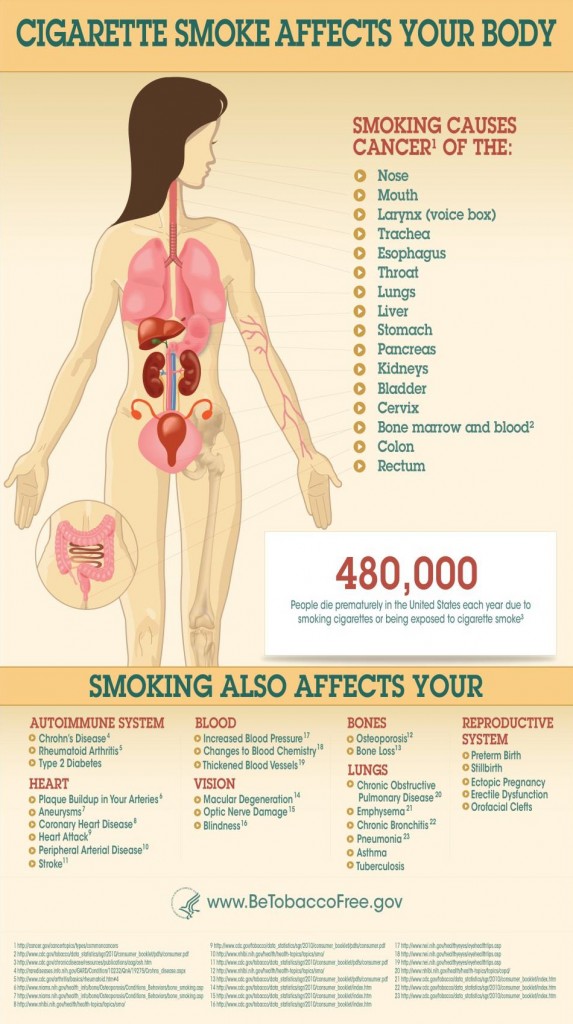Joseph R. Anticaglia MD
Medical Advisory Board
If one asks; how does cigarette smoke affects your body? Many will answer, “It causes lung cancer.” However, often overlooked, smoking affects almost every organ in the body, especially the cardiovascular system (stroke, hypertension, heart attack).
This year, at the end of May, social media and other media outlets were abuzz with messages to stop the use of tobacco for at least one day. We’ve heard and seen the story, time and time again, how people become addicted to the use of tobacco.
Act 1
I started smoking tobacco as a teenager
Act 2
I’ve been smoking all my life
Act 3
Disease >> Cancer >> Disability >> Death
Trailer
Before dying, a private or public plea, “I wish I never got started smoking.”
Every May 31 for the past 30 years, the World Health Organization encourages people in countries throughout the world to observe a day without the use of tobacco. “World No tobacco Day” (WNTD) draws worldwide attention to the harmful health effects due to tobacco use. It offers strategies to prevent people from starting to smoke and ways to quit smoking.
According to WHO, “Tobacco use kills more than 7 million people every year and costs households and governments over 1.4 trillion dollars through healthcare costs and lost productivity. It poisons the environment, threatens women, children and livelihoods.”
The member states of the World Health Organization created “World No Tobacco Day” in 1987. Since its creation, every year the WHO committee selects a central theme that sparks awareness to the dangers of smoking tobacco — the danger it causes to ‘one self,’ to the people around the smoker and the environment.

By Plenz — “eignehandig fotgrafiert” CCBY-S Ashtray with fresh flowers is a common symbol of World No Tobacco Day
World No Tobacco Day’s initial theme was, “1st Smoke Free Olympics” (1988 Olympic Winter Games – Calgary). Some of the WNTD themes in past years have been:
- Smoke free work and public places
- A ban on smoking in private cars in the presence of children
- A display ban at the point of sale
- Smoke free inside
- Second hand smoke kills!
- An increase in excise tax
- Banning advertising and marketing,
- Plain packaging for tobacco products
- The theme for 2017 is: Tobacco – ‘A Threat to Development.’
The message of the World Health Organization to governments across the globe is straight forward – to reduce the use of tobacco in all its forms.
Some countries have enacted more of the WHO recommendations than others. However, the tobacco industry with its formidable presence continues to influence both the government and the public regarding tobacco usage.
Many governments inform its citizens that it’s particularly important for them to stop smoking if they have type 2 diabetes, hypertension, cancer, COPD, suffered a stroke or heart attack.
Below is an illustration published by the U.S. Department of Health and Human Services (HHS) concerning the harmful effects of smoking cigarettes. Notice, 480,000 people die prematurely each year in the U.S. due to cigarette smoke.

HHS — Effects of Smoking on Your Health
One takeaway which freely crosses international borders, as put forth by the tobacco company, Philip Morris, in a press release back in 1999 in part says:
“Cigarette smoking is addictive and causes serious diseases. Smokers are far more likely to develop serious diseases like lung cancer than non‐smokers. There is no safe cigarette!”
References
Health and Human Services (HSS); Effects of Smoking on Your Health; Be Tobacco Free .gov
Friedman, L C; Philip Morris’s Website and Television Commercials Use New Language to Mislead the Public; Tob Control; Dec 2007
Philip Morris, Quit Assist.org
WHO; Say No to Tobacco; World No Tobacco Day; May 31, 2017
CDC; Health Effects of Smoking Tobacco; May 15, 2017
This article is intended solely as a learning experience. Please consult your physician for diagnostic and treatment options.

